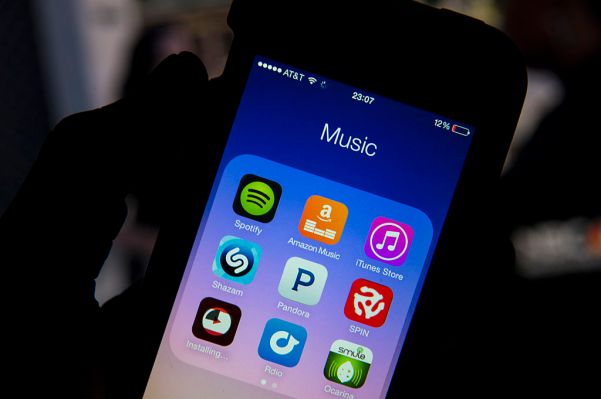Pandora, in a story we’ve seen before with many other maturing companies, is facing an existential crisis.
The company now finds itself fighting for its life against competition from the core platforms its service exists on: Android and iOS. Both of them — and Amazon as well — have launched their own music-streaming products, and they’re baked into the core experience. They’re cheap, effective and could even be an inch away from offering a better free experience that serves as an add-on to keep people locked into an ecosystem.
Not surprisingly, Pandora’s listener count dropped as the company reported its latest earnings report. Apple Music already hit 13 million subscribers in less than a year after it launched, while Pandora’s listeners fell to 78.1 million from 79.4 million in the same quarter a year ago. The company had a bit of a wild day, with reports first emerging that the company would be bought out, and then the company reporting poor results for its most recent quarter. In the past year, Pandora has shaved off more than a tenth of its value.
[graphiq id=”edfC3mTDJ53″ title=”Pandora Media Inc. (P) Stock Price – 1 Year” width=”600″ height=”463″ url=”https://w.graphiq.com/w/edfC3mTDJ53″ link=”http://listings.findthecompany.com/l/11470696/Pandora-Media-Inc-in-Oakland-CA” link_text=”Pandora Media Inc. (P) Stock Price – 1 Year | FindTheCompany”]
If the story sounds familiar, it should. We saw the emergence of Dropbox and its incredible rise to prominence in the early days of the cloud era in technology. Users adored the dead-simple tools that allowed them to store, access and modify their files across multiple devices. But the notion of what a “file” is has completely changed, and the owners of the core platforms now offer their own spin on what online storage looks like — and it looks a lot different than it did a few years ago.
Pandora, too, was a darling. It became one of the earliest ways to stream music online in a unique experience that simply wasn’t available on mobile devices before. Suddenly, listeners had access to an experience that was both comprehensive and rife with the potential of discovering new music. One of Pandora’s biggest strengths was its ability to match up similar types of music and serve up compelling channels, keeping listeners glued to its service.
But algorithms mature, data becomes more ubiquitous and finding edges like Pandora’s strength in discovery becomes easier and easier as time goes on. Inevitably a lot of products become commoditized, whether that’s music streaming or cloud storage. Even Spotify, an on-demand music experience, has found itself creating a compelling discovery experience. Pandora has been around for so long, yet let so much competition catch up — including platform owners.
In its lifetime, Pandora has seen itself rise to incredible highs (as much as triple its current share price) and low lows (all the way down to a potential buyout that represented less than half that high). Over the course of its life, the company’s shares have net fell about 20 percent. That might not seem like much, but similarities can be drawn between other stagnant companies that start to face existential crises. (Even Microsoft in the Steve Ballmer era might not be a bad comparison.)
Dropbox isn’t a public company, but it’s certainly faced its own fiscal criticism. The company has been repeatedly marked down by late-stage investors and mutual funds. There is plenty of hand-waving in setting the valuations for private companies, but nonetheless there’s an analogue to be seen between the similar optics between the two companies.
What this means for Pandora is that it needs to find a way to diversify its revenue. It’s clearly trying to show that it can. Pandora’s core radio product has two revenue streams: advertising and paying customers. It bought Ticketfly for $450 million last year, which sought to extend the listening experience into the real world by offering a bridge between the app and live experiences. And it bought Rdio’s assets for $75 million — with the hope that it could come out with its own on-demand experience.
However, none of those revenue streams appears to be actualizing into a core area of growth. That’s a problem. In this sense, it might make sense for Pandora to exist within a larger empire, either as a loss-leading user acquisition tool or buying enough time for the company to find a logical path to strong profitability.
Dropbox has found itself diving deep into enterprise products in order to attract a paying customer base beyond its traditional core cloud storage users. Microsoft gave up locking out its office products on PCs and opened it up to mobile devices outside its own platforms. You can see this happening with many companies at various stages of their lives, and Pandora is simply entering its era where it critically needs to innovate in order to survive.
Apple, too, has been working to diversify its revenue streams as its smartphone sales start to sag. So it seems unlikely that Apple would pull the trigger and make the service free. But as a way, for example, to introduce and lock people into the Amazon Prime ecosystem — much more lucrative than just an individual streaming service — a much cheaper streaming option seems to make more sense, and in the end if it’s a comparable experience it’s better for the customer.
Dropbox may have found its feet in its efforts to broaden its tools beyond simple cloud storage. Dropbox CEO Drew Houston said earlier this year that the company was “cash flow positive” (though there are probably a couple of ways to interpret that).
But, either way, we’ve seen a story similar to this before. And Pandora needs to adapt in order to survive.
